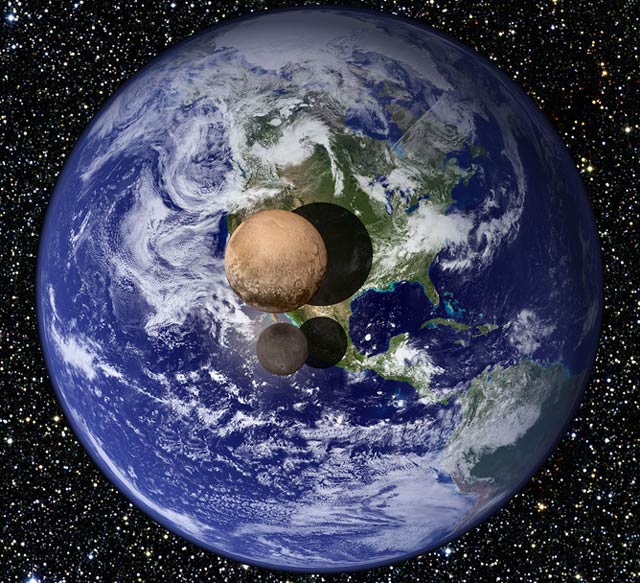
When New Horizons phoned home on Wednesday morning after its close encounter with Pluto, there was jubilation and excitement.
Now, as Pluto retreats into the distance, the slow trickle of data can begin. Sent to us at a rate of just 1kbit/s, it will take months to receive it all, and astronomers around the world are waiting on tenterhooks to get their hands on the data.
Like our own Earth, Pluto has an oversized satellite, Charon. It was discovered back in 1978 and is more than half the diameter of its parent.
Over the past few years, intense observation of Pluto in preparation for New Horizons’ arrival has revealed four more tiny satellites, Hydra and Nix, and tiny Kerberos and Styx.
But how did this satellite system come to be? And why the striking similarity to our double-planet?
If we look at the great majority of satellites in our solar system we find that they can be split into two groups. First, have those that we think formed around their host planet like miniature planetary systems, mimicking the process of planet formation itself.
These regular satellites most likely accreted from disks of material around the giant planets as those planets gobbled up material from the proto-planetary disk from which they formed. This explains the orbits of those satellites — perfectly aligned with the equator of their hosts and moving on circular orbits.
Then we have the irregular satellites. These are (with a couple of noteworthy exceptions) tiny objects, and move on a wide variety of orbits that are typically great distances from their host planets.
These, too, are easily explained — thought to be captured from the debris moving around the solar system late in its formation, relics of the swarm of minor bodies from which the planets formed.
By contrast, our moon and Pluto’s Charon are far harder to explain. Their huge size, relative to their host, argues against their forming like the regular satellites. Likewise, their orbits are tilted both to the plane of the equator and to the plane of the host body’s orbit around the sun. It also seems very unlikely they were captured — that just doesn’t fit with our observations.
The answer to this conundrum, in both cases, is violent.
Like our moon, Charon (and by extension Pluto’s other satellites) are thought to have been born in a giant collision, so vast that it tore their host asunder. This model does a remarkable job of explaining the makeup of our own moon, and fits what we know (so far) about Pluto and its satellites.
Pluto and its moons will therefore be the second shattered satellite system we’ve seen up close, and the results from New Horizons will be key to interpreting their formation.

Studying the similarities and differences between Pluto and Charon will teach us a huge amount about that ancient cataclysmic collision. We already know that Pluto and Charon are different colours, but the differences likely run deeper.
If Pluto was differentiated at the time of impact (in other words, if it had a core, mantle and crust, like the Earth) then Charon should be mostly comprised of material from the crust and mantle (like our moon). So it will be less dense and chemically different to Pluto. The same goes for Pluto’s other moons: Nix, Hydra, Styx and Kerberos.
Pluto, the unknown
The most exciting discoveries from New Horizons will likely be those we can’t predict. Every time we visit somewhere new, the unexpected discoveries are often the most scientifically valuable.
When we first visited Jupiter, 36 years ago, we found that its moon Io was a volcanic hell-scape. We also found that Europa hosts a salty ocean, buried beneath a thick ice cap. Both of these findings were utterly unexpected.
At Saturn, we found the satellite Mimas looked like the Death Star and another, Iapetus, like a two tone cricket ball, complete with a seam. Uranus had a satellite, Miranda, that looked like it had been shattered and reassembled many times over, while Neptune’s moon Triton turned out to be dotted with cryo-volcanoes that spew ice instead of lava.
The story continues for the solar system’s smaller bodies. The asteroid Ida, visited by Galileo on its way to Jupiter, has a tiny moon, Dactyl. Ceres, the dwarf planet in the asteroid belt, has astonishingly reflective bright spots upon its surface.

Pluto, too, will have many surprises in store. There have already been a few, including the heart visible in the latest images — possibly the most eye-catching feature to date. The best is doubtless still to come.
Despite the difficulties posed by being more than four and a half billion kilometres from home, New Horizons is certain to revolutionise our understanding of the Pluto system.
The data it obtains will shed new light on the puzzle of our solar system’s formation and evolution, and provide our first detailed images of one of the system’s most enigmatic objects.
But the story doesn’t end there. Once Pluto recedes into the distance, New Horizons will continue to do exciting research. The craft has a limited amount of fuel remaining, nowhere near enough to turn drastically, but enough to nudge it towards another one or two conveniently placed targets.
Since the launch of New Horizons, astronomers have been searching for suitable targets for it to visit as it hurtles outward through the Edgeworth-Kuiper belt, en route to the stars.
In October 2014, as a result of that search, three potential targets were identified. Follow-up observations of those objects narrowed the list of possible destinations to two, known as 2014 MU69 (the favoured target) and 2014 PN70.
The final decision on which target to aim for will be taken after New Horizons has left Pluto far behind, but we can expect to keep hearing about the spacecraft for years to come.![]()
- Jonti Horner is vice chancellor’s senior research fellow at University of Southern Queensland, while Jonathan P Marshall is vice chancellor’s post-doctoral research fellow at UNSW Australia
- This article was originally published on The Conversation

